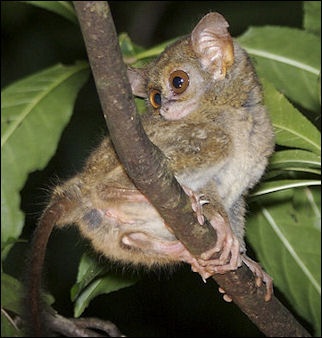Paleontologists led by Dr Jelle Zijlstra from Harvard’s Peabody Museum have discovered a new genus and species of tarsier that lived in what is modern-day Pakistan during Miocene, between 18 and 16 million years ago.

Extant tarsier species: Philippine Tarsier (Tarsius syrichta). Image credit: Jasper Greek Golangco.
Tarsiers are small, nocturnal, predaceous primates found only in the islands of southeast Asia, including Sumatra, Borneo, Sulawesi, and Philippines. They are intermediate in form between lemurs and monkeys, measuring up to 15 cm long and weighing 100 – 150 g.
These primates have very large eyes, elongated hind legs and feet, a thin tail and long fingers. Their fur is velvety or silky and buff, grayish brown, or dark brown on the back and grayish or buffy on the underside.
Tarsiers are rare in the fossil record. Until now, only four fossil species have been known: two from the Eocene of China and two from the Miocene of Thailand.
The new Miocene species, named Hesperotarsius sindhensis, is described from four fossil teeth found in the Manchar Formation of Sindh Province, southern Pakistan.

Fossil teeth of Hesperotarsius sindhensis. Image credit: Zijlstra JS et al.
“The Pakistani tarsier is morphologically distinct from all living and fossil tarsiers, but most similar to the middle Miocene Thai species Tarsius thailandicus,” Dr Zijlstra with colleagues wrote in a paper published in the Journal of Human Evolution.

The genus name, Hesperotarsius, is derived from the Greek word hesperos (meaning western), combined with Tarsius, the type genus of the family Tarsiidae. The species is named after the Pakistani province of Sindh.

The discovery of Hesperotarsius sindhensis extends the range of the family Tarsiidae more than 4,000 km to the west, according to Dr Zijlstra’s team.
Source: sci.news









